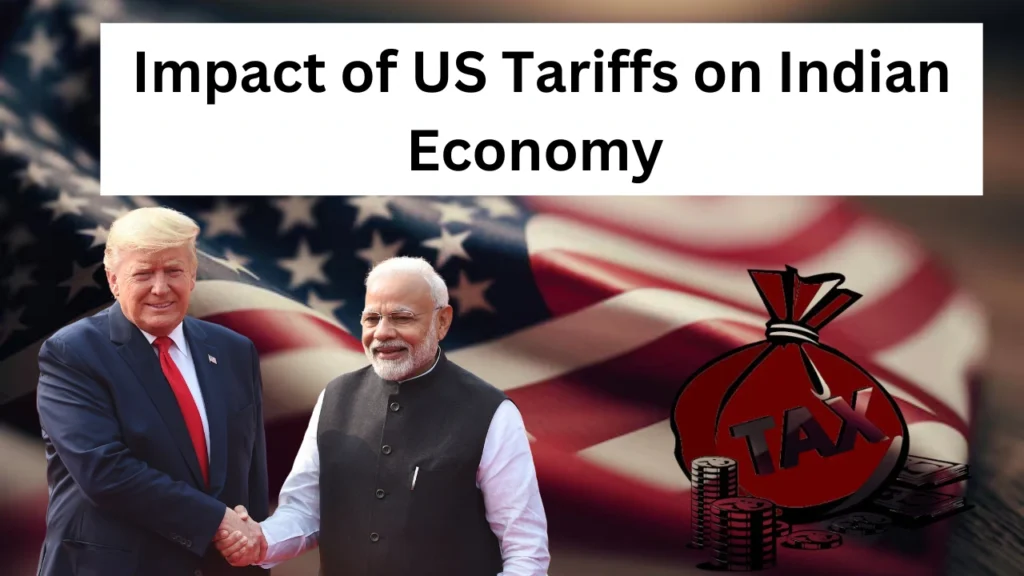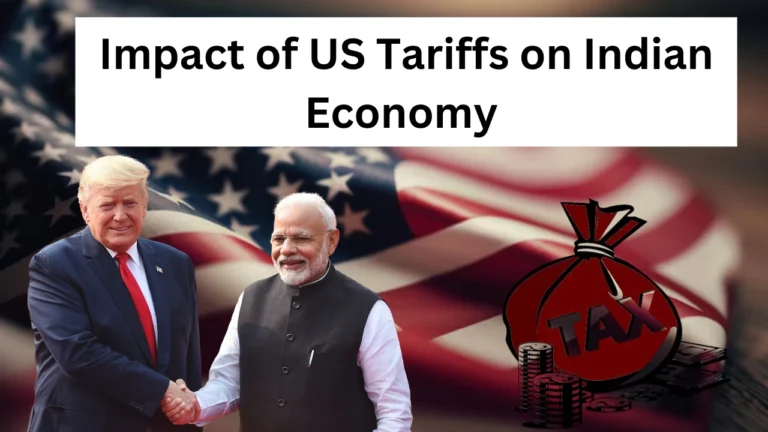The recent announcement of high import tariffs by US President Donald Trump has raised serious concerns for global markets, and India Inc. is closely watching the possible consequences. While global trade is witnessing a shift due to these new reciprocal tariff measures, India’s finance ministry remains cautiously optimistic about maintaining the country’s projected GDP growth for FY 2025-26.

India’s Economic Growth Outlook Despite US Tariff Shocks
India is projected to grow between 6.3% to 6.8% in the fiscal year 2025-26. According to senior officials at the Union Finance Ministry, this target remains achievable if crude oil prices stay below $70 per barrel. However, global disruptions stemming from the U.S. tariffs are likely to cast a shadow on exports and investor sentiment.
Economists Trim Growth Forecasts
Several economists and institutions, including Goldman Sachs, have revised India’s growth forecast down by 20–40 basis points, estimating the GDP growth for 2025/26 at 6.1%. This is largely attributed to fears of a slowdown in global trade and a potential drop in exports due to Trump’s tariff policy.
Impact of Trump’s 2025 Tariffs on India: Sector-Wise Economic Analysis
The U.S. government’s recent move to impose a 26% tariff on Indian imports, along with even higher tariffs on Chinese goods, has sparked fears of a global trade disruption. The implications for India could be significant, particularly for export-heavy industries.
Key Highlights:
- A 26% tariff on Indian imports to the United States.
- Even steeper duties on Chinese products, escalating global trade tensions.
- India’s diamond exports—a sector that heavily depends on U.S. demand—may suffer major losses.
- Thousands of export-based jobs across multiple industries could be at risk.
Sector-Wise Impact of U.S. Tariffs on Indian Industries
| Sector | Impact Summary |
|---|---|
| Automobile and Auto Ancillaries | Companies like Tata Motors (JLR) face risks due to large U.S. market exposure. Bharat Forge and Sona BLW may also be affected. |
| Gems and Jewellery | U.S. is a major buyer (1/3rd of exports). Tariffs may hurt competitiveness and lead U.S. retailers to seek alternatives. |
| Textiles | India may gain from lower tariffs, but competing nations like China, Vietnam, and Bangladesh could flood Indian markets, hurting local manufacturers. |
| Metals | Steel already faces a 25% tariff since 2018; new hikes may worsen conditions as countries like China could dump excess metal in India. |
| Pharmaceuticals | Pharmaceuticals are exempt from initial tariffs, but future actions remain unclear. Companies like Sun Pharma and Lupin are monitoring developments closely. |
Sectors That May Be Hit the Hardest
Among all the sectors, the Indian diamond industry stands out as potentially the most affected. Over one-third of India’s diamond exports go to the U.S., and the steep tariffs could significantly undermine the industry’s competitiveness. This may lead to:
- Massive job losses, especially in Gujarat’s diamond hubs,
- A drop in production output,
- U.S. retailers shifting to alternative markets like Thailand or Israel.
Other export-driven industries—such as textiles, pharmaceuticals, and auto components—are also on high alert, especially those with substantial exposure to U.S. markets.euticals, and automotive components may also experience pressure due to declining demand and higher entry barriers in the U.S. market.
Government Action: Export Support and No Retaliation for Now
In response, the Commerce Ministry has submitted four to five proposals to the finance ministry to aid struggling export sectors. These proposals include:
- Extension of the interest subsidy scheme,
- Financial aid for market diversification,
- Increase in bank credit support to exporters.
The finance ministry has stated that they are studying the impact of these tariffs, and any decision will be made at the appropriate time. For now, India does not plan to retaliate with counter-tariffs, as officials aim to resolve the matter diplomatically.
In response to the evolving trade landscape, the Indian government is actively assessing potential scenarios and formulating strategies to mitigate adverse impacts. The Commerce Ministry is working on various scenarios to evaluate the possible fallout of the U.S. tariffs, considering the uncertainty over the quantum and manner of these levies. Additionally, a control room has been established to monitor announcements related to the tariffs, ensuring that policymakers remain informed and responsive.
Market Reaction: Investor Wealth Takes a Hit
The financial markets reacted sharply to the trade war fears. On Monday, the BSE Sensex crashed by 3,939.68 points, marking a 5.22% fall, wiping out investor wealth worth ₹20.16 lakh crore. The Nifty and other benchmark indices mirrored the steep fall, signaling widespread concern across sectors.
Industry Leaders’ Perspectives
Despite the challenges posed by the tariffs, some industry leaders remain optimistic about India’s resilience.
“India’s strong domestic base, improving ease of doing business, and diversified trade relationships will help us navigate these global trade disruptions. Our ongoing negotiations, including Mission 500, may pose short-term challenges, but I am confident that India will emerge as a winner in the long run.”
— Nitinkumar Parekh, CFO, Zydus Lifesciences
India Inc Remains Cautiously Optimistic
Despite the immediate shocks, industry leaders and trade analysts believe India’s diversified trade portfolio and strong domestic demand can help cushion the blow. Many experts argue that the long-term impact could be more adverse for the U.S., especially as countries begin to reduce reliance on American markets and explore regional trade alternatives.
Conclusion
While the U.S. tariffs introduce a layer of complexity to India’s trade dynamics, the nation’s diversified economy, proactive government measures, and strategic trade relationships position it to navigate these challenges effectively. Continuous dialogue with global partners and adaptive strategies will be crucial for India to maintain its growth trajectory amidst the shifting sands of international trade.

